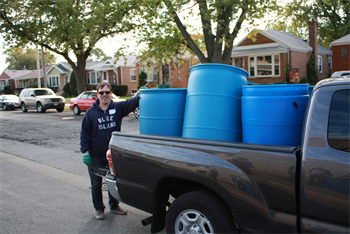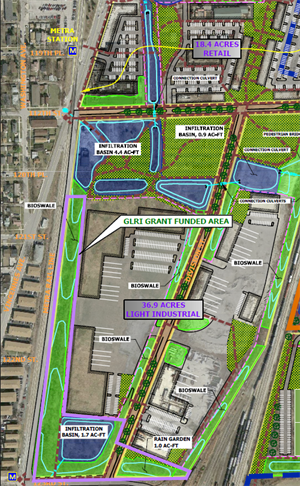
Jason Berry
Governor Quinn (center) poses with Mayor Vargas (left) of Blue Island after announcing a major investment in green infrastructure for Blue Island
Exciting news came to the City of Blue Island last Saturday as Governor Pat Quinn stopped by on a sunny fall afternoon to announce $1.1 million in investments from the state on stormwater management and green infrastructure. The announcement builds upon several years of momentum on stormwater issues in Blue Island, which lies just south of Chicago in the area now known as the Millennium Reserve. This momentum leverages expertise, funding and the energy of local community members to tackle stormwater at every scale and make a positive impact on a neighborhood.
Blue Island’s progress over the years provides a great case study of what can be brought to bear on stormwater with the right collaborations and attention. Attending the Governor’s press event made me reflect on the need to share the great work happening there; residents should know about it and other communities can learn from it.

Anja Ruszaj
Blue Island distributed 125 rain barrels in 2012 and will now be giving out more throughout the city in partnership with MWRD.
I was lucky to be part of the City’s efforts early on, when the Metropolitan Planning Council (MPC), along with many other partners, including the Ill. Dept. of Natural Resources, Illinois-Indiana Sea Grant, Cook County South Suburban Master Gardeners, Blue Island Park District, OAI, a workforce development group, and others launched Blue Island, Blue Water, a neighborhood rain barrel and native plant project to get the word out about green infrastructure to community members in the City’s frequently flooded northeast neighborhood. While the stormwater benefits from the project were modest, the social and political gains from awareness and collaboration were immense—residents and business owners became aware of how they can help be part of the solution, elected leaders and municipal staff became more literate on stormwater and green infrastructure and countless other organizations now pay attention to and invest in local issues.

Abby Crisostomo
Blue Island Alderman Jim Johanson pitches Blue Island’s new rain barrel program to local residents. Created in partnership with MWRD, rain barrels are available free to qualified property owners.
The project led Blue Island to put together a grant application (with MPC’s assistance) for green infrastructure investments on public land in that same neighborhood, as well as wetland restoration at a vacant site nearby. Though they didn’t originally get that funding, they were well poised to partner with the Metropolitan Water Reclamation District of Greater Chicago, which not long after chose to invest in green infrastructure in Blue Island as one of its early municipal stormwater infrastructure projects. The District will be planting seven parkway rain gardens and installing two permeable parking areas. Additionally, the Ill. Dept. of Natural Resources went back to the neighborhood to follow up with residents and community leaders on long-term maintenance, eventually creating a series of guides not only for them, but for the whole region. And then when the District recently unveiled its new rain barrel distribution program, Blue Island was ready from its earlier experience to be the first community to sign up.
Throughout these projects, there have been many successes, but also bumps along the road. Lessons learned from these original Blue Island, Blue Water projects informed much of MPC’s research on private property incentive programs for stormwater, as well as much of the early work of the newly minted Calumet Stormwater Collaborative, a collaboration of local governments and stormwater groups that in turn allows us to turn around and apply the lessons from our regional policy efforts back on the ground in Blue Island and other communities.

Weaver Boos Consultants
Investments in green infrastructure at a former landfill adjacent to Blue Island's target neighborhood will help foster stormwater sensitive development in the future.
Thanks to relationships and discussions that would not have happened but for the Collaborative, there has been even more leveraging of resources to ensure that groups around the region are coordinating with each other and not doing one-off, scattered projects. The South Suburban Mayors and Managers Association, in partnership with Chicago Wilderness and the Ill. Dept. of Natural Resources, has allocated a portion of their Great Lakes Restoration Initiative funds to supplement the green infrastructure investments by adding one more parkway rain garden to those being built by the Metropolitan Water Reclamation District, with construction starting next week. That group has also submitted for funding for more wetland restoration from the Chi-Cal Rivers Fund. The District is also launching five pilot studies to develop local stormwater infrastructure plans, selecting two in the Calumet region. One of these is a consortium of communities that includes Blue Island.

Courtesy of Jason Berry
Intense rains in July 2014 led to flooding in sections of Blue Island. The City, residents and regional partners are taking action to minimize flood risk in the future.
Finally, after a recent bout of local flooding, Blue Island hosted a community meeting, inspired by the Center for Neighborhood Technology’s Rain Ready initiative, to allow residents to talk with community leaders and local experts about flooding concerns. From that meeting, residents were able to hear about the Metropolitan Water Reclamation District’s review of sewer capacity in the area, learn the City’s considerations of a incentive programs for property-level flooding prevention and join together to create a Resident Action Group to collect house-by-house data to help neighbors and engineers address specific problems.
It was an inspiring moment when Governor Quinn opened his remarks by saying, “We’re here in Blue Island and that means Blue Water!” With his announcement of additional investment from the Ill. Environmental Protection Agency to help support the efforts of Blue Island, its partners and many others that can learn, everyone’s investments are ensured even better success. Blue Island has been particularly successful thanks to their ability to identify the stormwater need and actively seek out partners with the expertise and resources to fill that need. With continued collaboration between government and community, we hope to see many more coordinated stormwater dollars flooding our region’s municipalities. Here’s to the good kind of flooding!